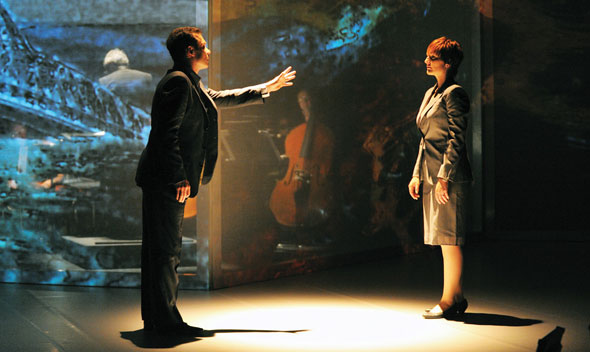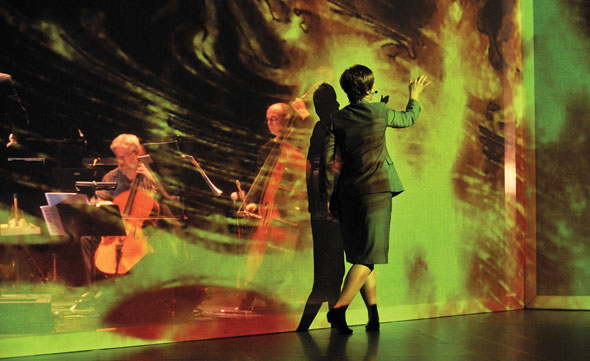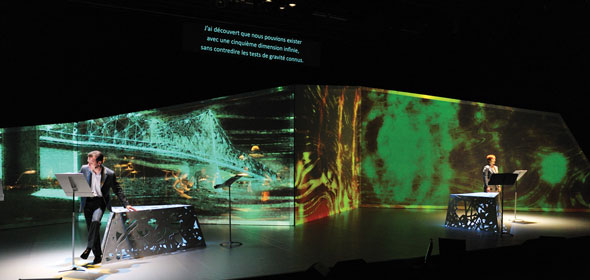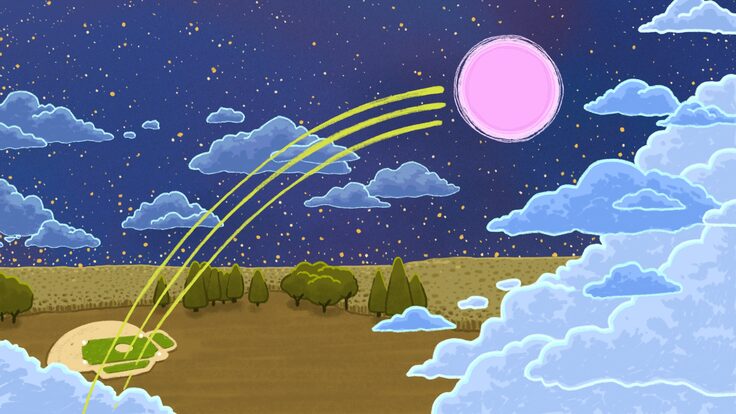Gallery: Hypermusic prologue
What opera and physics may have in common, more than anything else, is their tendency to make most people cringe or fall asleep. Can an avant-garde opera that compares self-exploration to the physics of multiple dimensions invigorate audiences? The creators of Hypermusic Prologue, A Projective Opera in Seven Planes seem to think so.
Text by Calla Cofield
Photography by Aymeric Warmé-Janville
 |
| Baritone James Bobby and soprano Charlotte Ellett explore their relationship in extra dimensions. |
Hector Parra learned about physics from his father and studied it until he was 18, when, as he says, The piano took all of my energy. Now a composer, Parra has an unmistakable passion for operas grand expression of human emotion. Yet he also rebels against traditional styles of composition. His latest work, called Hypermusic Prologue, A Projective Opera in Seven Planes, is so different from classical opera in subject matter and musical style that Parra says, I dont know if its an opera. Its an experience.
Hypermusic Prologue is about the physics of extra dimensions. It was inspired by the book Warped Passages by Lisa Randall, a professor of theoretical physics at Harvard University. Parra was so moved by the book that he asked Randall to write the librettosomething she had never done before. But she hopped on board and wrote a love story sprinkled with ideas from her physics research. Based on that story, Parra composed music that expresses frustration, desire, passion, and the experience of traveling into the fifth dimension.
The two characters, a soprano and a baritone, live on the same stage and interact day to day. But the soprano is searching for change and depth, and longs to explore higher dimensions. The baritone is satisfied with a static world, where he remains while his companion finally breaks through. To save the relationship, he must also make the leap and follow her.
At times, Parras score is a collection of disjointed noises. It is rarely melodic, and segments often stop before any kind of recognizable song structure develops. The percussionist uses odd instruments such as broken glass in a crystal container, wood scratching on a chalkboard, and a makeshift instrument that sounds like a furiously scribbling pen. Yet this style works well to illustrate the characters inner turmoil and rocky relationship.
The baritones half of the stage, a static world of concrete objects and pale colors, is ruled by classical physics. On the other half, the soprano journeys through vibrant colors, warping shapes, and twisting scenery. Both sometimes express themselves in physics terms:
Soprano: The forces change
[She moves across the stage. Different
colors converge.]
as distances change
As I travel through this extra dimension
::Musical interlude where forces
converge. Crescendo as they all merge
into a single sound::
As I travel away
forces come together
Unite
 |
| Rather than concealing the orchestra in a pit, set designer Matthew Ritchie put it on stage behind a screen that becomes translucent when the lighting is right. |
The set was designed by artist Matthew Ritchie, who is based in New York City and knew Randall from previous ventures into artistic representation of science. While the set incorporates physics ideasdistortion of the fabric of space-time, for instance, is reflected in spiraling images and tie-dye swirls of colorhe says the visuals were not meant to be direct translations of those ideas. I want to tread carefully because its not science, Ritchie says. Its a kind of emblem.
To create the illusion of traveling through a different dimension, Ritchie projected video onto a gray stage. This allowed rapid background changes and intricate, morphing color schemes. While the orchestras for most opera performances are concealed in a pit in front of the stage, the musicians in Hypermusic sit onstage behind a screen that becomes translucent when the lighting is right, so they appear in the same space as the singers.
With three creative minds completing most of the work for the opera from different locations Parra in France, Randall in Massachusetts, and Ritchie in New YorkHypermusic Prologue could have been a train wreck of ideas; instead it manages to be harmonious, engaging, and adventurous.
The production debuted in Europe in the summer of 2009 and continues to tour. Excerpts from the opera are scheduled for performance January 11th and 12th at the Guggenheim Museums Spiral Hall in New York City. Parra says he hopes to bring the full production to the United States in 2011.
 |
| Each of the two singers occupies half of the stage. The baritone lives in the static, concrete world of classical physics. The sopranos colorful, vibrant world reflects her longing for change and depth. |
Click here to download the pdf version of this article.






